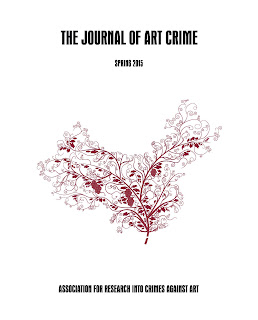Thursday, July 23, 2015 -  Adam Worth,art thief,book review,Spring 2015 issue,the Journal of Art Crime
Adam Worth,art thief,book review,Spring 2015 issue,the Journal of Art Crime
 No comments
No comments
 Adam Worth,art thief,book review,Spring 2015 issue,the Journal of Art Crime
Adam Worth,art thief,book review,Spring 2015 issue,the Journal of Art Crime
 No comments
No comments
Book Review: Catherine Schofield Sezgin on "The Napoleon of Crime: The Life and Times of Adam Worth" by Ben Macintyre
Catherine Schofield Sezgin reviews "The Napoleon of Crime: The Life and Times of Adam Worth" by Ben Macintyre in the Spring 2015 issue of The Journal of Art Crime, edited by Noah Charney (with Marc Balcells and Christos Tsirogiannis) and published by ARCA:
Ben Macintyre’s 1997 book, The Napoleon of Crime: The Life and Times of Adam Worth is written by the journalist who pro- duced Agent Zigzag: A True Story of Nazi Espionage, Love, and Betrayal, an empathetic view of a triple agent during World War II. In the preface, Macintyre explains that he found the story of Worth in the archives of the Pinkerton Detective Agency in Los Angeles by chance when he saw a 1902 “fragment of a newsprint” from the Sunday Oregonian in Portland that claimed “Adam Worth, Greatest Thief of Modern Times; Stole $3,000,000.”
Macintyre explains:
The detectives, I soon learned, had hunted Worth across the world for decades with dogged perseverance, and the result was a wealth of documentation: six complete chronological folders, tied together with string and bulging with photographs, letters, newspaper articles, and hundreds of memos by the Pinkerton detectives, each one written in meticulous copperplate and relating a tale even more intriguing and peculiar than the nameless Sunday Oregonian writer had implied.For Adam Worth, it transpired, was for more than simply a talented crook. A professional charlatan, he was that most feared of Victorian bogeymen: the double man, the charming rascal, the respectable and civilized Dr. Jekyll by day whose villainy emerged only under cover of night. Worth made a myth of his own life, building a thick smokescreen of wealth and possessions to cover a multitude of crimes that had started with picking pockets and desertion and later expanded to include safecracking on an industrial scale, international forgery, jewel theft, and highway robbery. The Worth dossiers revealed a vivid rogues’ gallery of crooks, aristocrats, con men, molls, mobsters, and policeman, all revolving around this singular man. In minute detail the detectives described his criminal network, radi- ating out of Paris and London and stretching from Jamaica to South Africa, from America to Turkey.
Catherine Schofield Sezgin is editor of the blog for the
Association of Research into Crimes against Art (ARCA) and a 2009
graduate of its certificate program in International Art Crime.
Here's a link to ARCA's website about access to The Journal of Art Crime.



